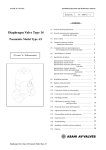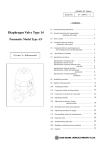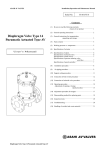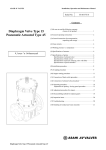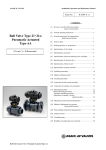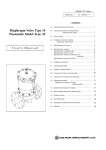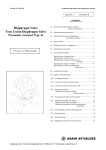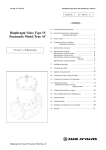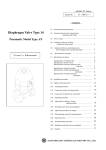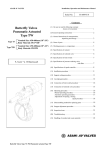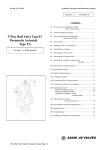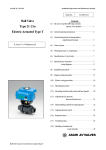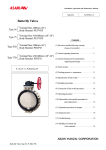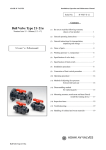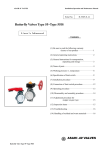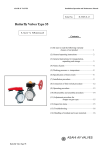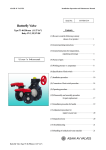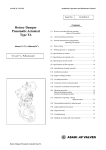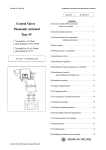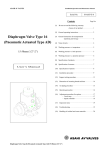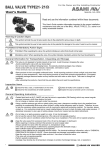Download Diaphragm Valve Type 14 True Union Diaphragm Valve Type 14
Transcript
ASAHI AV VALVES
Installation, Operation and Maintenance Manual
Serial No.
H-A007-E-12
Contents
(1)
Diaphragm Valve Type 14
True Union Diaphragm Valve
Type 14
Pneumatic Actuated Type AN
Be sure to read the following warranty
clauses of our product
1
(2)
General operating instructions
2
(3)
General instructions for transportation,
unpacking and storage
3
(4)
Name of parts
4
(5)
Working pressure vs. temperature
5
(6)
Comparison between operating pressure
and working pressure and opening degree
6
(7)
Specifications of actuator
6
User’s Manual
(8) Specification of options
Specifications of solenoid valve
Specifications of limit switch
Specifications of pressure reducing valve
with filter
Specifications of speed controller
Specifications of fully open adjustment
mechanism
Specifications of manual operating
mechanism
(9)
Installation procedure
7
7
8
8
9
9
9
10
(10)
Support setting procedure
14
(11)
Air piping procedure
15
(12)
Connection of limit switch procedure
17
(13)
Connection of solenoid valve procedure
18
(14)
Operating procedure
19
(15)
Adjustment of opening / closing
speed procedure
20
(16)
Mounting insert-metal and base (panel)
22
(17)
Adjustment procedure for stopper
23
(18)
Disassembling method for replacing parts
25
(19)
Installation procedure
of fully open adjustment mechanism
26
(20)
Inspection items
27
(21)
Troubleshooting
27
(22)
Handling of residual and waste materials
28
ASAHI AV VALVES
Diaphragm Valve Type 14, True Union Diaphragm Valve Type 14 Pneumatic Actuated Type AN
ASAHI AV VALVES
Installation, Operation and Maintenance Manual
This user’s guide contains very important information for the proper installation, maintenance and safe use of
an ASAHI AV Product. Please store this manual in an easily accessible location.
<Warning & Caution Signs>
Warning
Caution
This symbol reminds the user to take caution due to the potential for serious injury or death.
This symbol reminds the user to take caution due to the potential for damage to the valve if used in
such a manner.
<Prohibited & Mandatory Action Signs>
Prohibited: When operating the valve, this symbol indicates an action that should not be taken.
Mandatory action: When operating the valve, this symbol indicates mandatory actions that must be
adhered to.
(1) Be sure to read the following description of our product warranty.
- Always observe the specifications of and the precautions and instructions on using our product.
- We always strive to improve product quality and reliability, but cannot guarantee perfection. Therefore, should
you intend to use this product with any equipment or machinery that may pose the risk of serious or even fatal
injury, or property damage, ensure an appropriate safety design or take other measures with sufficient
consideration given to possible problems. We shall assume no responsibility for any inconvenience stemming
from any action on your part without our written consent in the form of specifications or other documented
approval.
- The related technical documents, operation manuals, and other documentation prescribe precautions on selecting,
constructing, installing, operating, maintaining, and servicing our products. For details, consult with our
nearest distributor or agent.
- Our product warranty extends for one and a half years after the product is shipped from our factory or one year
after the product is installed, whichever comes first. Any product abnormality that occurs during the
warranty period or which is reported to us will be investigated immediately to identify its cause. Should our
product be deemed defective, we shall assume the responsibility to repair or replace it free of charge.
- Any repair or replacement needed after the warranty period ends shall be charged to the customer.
- The warranty does not cover the following cases:
(1) Using our product under any condition not covered by our defined scope of warranty.
(2) Failure to observe our defined precautions or instructions regarding the construction, installation, handling,
maintenance, or servicing of our product.
(3) Any inconvenience caused by any product other than ours.
(4) Remodeling or otherwise modifying our product by anyone other than us.
(5) Using any part of our product for anything other than the intended use of the product.
(6) Any abnormality that occurs due to a natural disaster, accident, or other incident not stemming from
something inside our product.
Diaphragm Valve Type 14, True Union Diaphragm Valve Type 14 Pneumatic Actuated Type AN
1
ASAHI AV VALVES
Installation, Operation and Maintenance Manual
(2) General operating instructions
Warning
Caution
Warning
- Never attempt to disassemble an actuator.
(If disassembled forcible, internal parts may jump out and this is very dangerous.)
- Do not touch the actuator when it operated.
- Using a positive-pressure gas with our plastic piping may pose a dangerous condition due to the
repellent force particular to compressible fluids even when the gas is under similar pressures used
for liquids. Therefore, be sure to take the necessary safety precautions such as covering the piping
with protective material. For inquiries, please contact us. For conducting a leak test on newly
installed piping, be sure to check for leaks under water pressure. If absolutely necessary to use a
gas in testing, please consult your nearest service station beforehand.
- Do not step on or apply excessive weight on valve. (It can be damaged.)
- Do not use AV valves in a place where they may become submerged in water.
- Do not use the valve in conditions where the fluid may have crystallized.
(The valve will not operate properly.)
- Keep the valve away from excessive heat or fire. (It can be damaged, or destroyed.)
- Always operate the valve within the pressure vs. temperature range.
(The valve can be damaged or deformed by operating beyond the allowable range.)
- Allow sufficient space for maintenance and inspection.
- Select a valve material that is compatible with the media. For chemical resistance information, refer to
“CHEMICAL RESISTANCE ON ASAHI AV VALVE”.
(Some chemicals may damage incompatible valve materials.)
- Keep the valve out of direct sunlight, water and dust. Use cover to shield the valve.
(The valve will not operate properly.)
- Perform periodic maintenance. (Leakage may develop due to temperature changes or periods of
prolonged storage, rest, or operation.)
- The travel stop may have to be adjusted if media leakage is detected between the upstream &
downstream sides of the valve.
- Bonnet bolt torque should be checked before installation, as they may become loose after long-term
storage. A periodic check of the valve condition as well as bonnet & flange bolt torque should be
made part of preventative maintenance program properly re-tightening the bolts as necessary. It is
especially important to re-tighten all bolts during the first shutdown.
- Set valve support on the valve.
- The AV valves must be used within the specifications specifically applicable to the product.
- The actuator of diaphragm valve have draw and exhaust vent.
(The back side)
The fluid might spout when the diaphragm is damaged by
the condition. Perform periodic maintenance.
Diaphragm Valve Type 14, True Union Diaphragm Valve Type 14 Pneumatic Actuated Type AN
2
ASAHI AV VALVES
Installation, Operation and Maintenance Manual
(3) General instructions for transportation, unpacking and storage
- When suspending and supporting a valve, take care and do not stand under a suspended valve.
Warning
Caution
- This valve is not designed to handle impacts of any kind. Avoid throwing or dropping the valve.
- Avoid scratching the valve with any sharp object.
- Do not over-stack cardboard shipping boxes. Excessively stacked packages may collapse.
- Avoid contact with any coal tar creosote, insecticides, vermicides or paint.
(These chemicals may cause damage to the valve.)
- Store products in their corrugated cardboard boxes. Avoid exposing products to direct sunlight, and
store them indoors (at room temperature). Also avoid storing products in areas with excessive
temperatures. (Corrugated cardboard packages become weaker as they become wet with water or
other liquid. Take care in storage and handling.)
- After unpacking the products, check that they are defect-free and meet the specifications.
Diaphragm Valve Type 14, True Union Diaphragm Valve Type 14 Pneumatic Actuated Type AN
3
ASAHI AV VALVES
Installation, Operation and Maintenance Manual
(4) Name of parts
No.
[1]
[3]
[3a]
[4]
[5]
[6]
[7]
[11]
[14]
[21]
DESCRIPTION
Body
Diaphragm
Inserted metal of diaphragm
Cushion
Cushion cover
Compressor
Joint
Gauge cover
O-ring(A)
Screw
No.
[24]
[25b]
[25c]
[25e]
[26]
[27]
[28]
[29]
[30]
[33]
DESCRIPTION
Ensat (insert metal)
End connector (Socket end type)
End connector (Threaded end type)
End connector (Spigot end type)
Union nut
O-ring(C)
Actuator(double acting)
Actuator(air to shut)
Actuator(air to open)
Compressor pushing plate
No.
[40]
[41]
[43]
[52]
[53]
[54]
[55]
[56]
Diaphragm Valve Type 14, True Union Diaphragm Valve Type 14 Pneumatic Actuated Type AN
DESCRIPTION
Bolt(B)
Indicative rod
Stopper
Manual shaft
Thrust ring
Rod for travel stop
Fitting for travel stop
Bolt &nut
4
ASAHI AV VALVES
Installation, Operation and Maintenance Manual
(5) Working pressure vs. temperature
Diaphragm Valve Type 14, True Union Diaphragm Valve Type 14 Pneumatic Actuated Type AN
5
ASAHI AV VALVES
Installation, Operation and Maintenance Manual
(6) Comparison between operating pressure and working pressure and opening
(7) Specifications of actuator
15mm, 20mm
(1/2”, 3/4”)
Nominal size
Operating pressure
MPa {kgf/cm2} [PSI]
Air consumption,
Nl/per [inch3]
1 opening of closing
(0.4MPa)
Air supply orifice
Double acting
Air to open
Air to shut
25mm, 32mm
(1”, 1 1/4”)
40mm
(1 1/2”)
50mm
(2”)
0.4-0.6 {4.1-6.1} [57-85]
Double acting
2.6 [160]
2.7 [170]
9.6 [590]
9.8 [600]
Air to open
0.8 [49]
0.8 [49]
3.4 [210]
3.4 [210]
Air to shut
1.8 [110]
1.9 [120]
6.1 [370]
6.3 [380]
Double acting
Air to open
Air to shut
Rc 1/4
Diaphragm Valve Type 14, True Union Diaphragm Valve Type 14 Pneumatic Actuated Type AN
6
ASAHI AV VALVES
Installation, Operation and Maintenance Manual
(8) Specifications of options
(Specifications of Solenoid valve)
Actuation
Nom. Size
Model No.
Pipe bore
Effective cross
section area
mm2(inch2)
Power
consumption
Additional function
- Bypass valve built – in
All type
15 (1/2”)
-50mm(2”)
4N3S102K-W□
-G31193
4N3S102K-W□-G31193
* ( )is special order.
connection diagram
Rc 1/4
10(0.016)
or more
AC ; 6VA
DC ; 5.5W
- Silencer with needle
Valve attached
(to be used as speed
controller)
Specification
sign
AC100V 50/60Hz
1
AC110V 50/60Hz
(2)
AC200V 50/60Hz
3
AC220V 50/60Hz
(4)
DC24V
5
DC48V
(6)
DC100V
(7)
DC125V
(9)
JIS sign
Diaphragm Valve Type 14, True Union Diaphragm Valve Type 14 Pneumatic Actuated Type AN
7
ASAHI AV VALVES
Installation, Operation and Maintenance Manual
(Specifications of limit switch)
Actuation
Nominal size
Type sign
Protection grade
Double acting
Air to open
Air to shut
15mm-50mm
(1/2” - 2”)
1LS19-J
IP67 (IEC529)
Limit switch rating
Rate voltage
(V)
connection diagram
Resistive load
(A)
Inductive load
(A)
AC125
10
6
AC250
10
6
DC125
0.8
0.2
DC250
0.4
0.1
(At intermediate opening)
(Specification of pressure reducing valve with filter)
Actuation
Nom. Size
Type sign
Pipe bore
Element degree of
filtration
All type
15mm-50mm
(1/2” - 2”)
ARU2-02-8A-B
Rc 1/4
5μm
JIS sign
Diaphragm Valve Type 14, True Union Diaphragm Valve Type 14 Pneumatic Actuated Type AN
8
ASAHI AV VALVES
Installation, Operation and Maintenance Manual
(Specification of speed controller)
Actuation
Nom. Size
Type sign
Pipe bore
All type
15mm-50mm
(1/2” - 2”)
SC7-08A
Rc 1/4
Effective cross section area
mm2(inch2)
Free flow
Control flow
11 (0.017)
8.3 (0.013)
Needle No. of
revolution
8 turns
(Specifications of fully open adjustment mechanism)
As to the block diaphragm and adjusting method, refer to pages 4 and 25, respectively.
(Specifications of manual operating mechanism (set only at air to open))
As to the block diaphragm and operating method , refer to pages 4 and 23, respectively.
Diaphragm Valve Type 14, True Union Diaphragm Valve Type 14 Pneumatic Actuated Type AN
9
ASAHI AV VALVES
Installation, Operation and Maintenance Manual
(9) Installation procedure
Flanged type
(Material : PVC, C-PVC, PP, PVDF)
- When suspending and supporting a valve, take care and do not stand under a suspended valve.
Warning
Caution
- Be sure to conduct a safety check on all hand and power tools to be used before beginning work.
- Wear protective gloves and safety goggles as fluid remain in the valve even if the pipeline is empty.
(You may be injured.)
- When installing a pipe support by means of a U-band or something similar, take care not to
over-tighten. (Excessive force may damage the pipe.)
- When installing pipes and valves, ensure that they are not subjected to tension, compression, bending,
impact, or other excessive stress.
- Before a water test, be sure that the flange is tightly fastened.
- Fasten the flange while avoiding the parallelism and axial misalignment of the flange surface.
- When connecting a ASAHI AV Valve to metal piping, take care not to let the pipe stress on the
ASAHI AV Valve.
- Use flat faced flanges for connection to AV Valves.
- Ensure that the mating flanges are of the same standards.
- Be sure to use sealing gaskets (AV Gasket), bolts, nuts, and washers and tighten them to specified
torques. (When a non-AV gasket is used, a different tightening torque instruction should be followed.)
Necessary items
● Torque wrench
● AV gasket
● Spanner wrench
● Bolt, Nut, Washer (For many flanges specification)
Procedure
1) Set the AV gasket between the flanges.
2) Insert washers and bolts from the pipe side, insert washers and nuts from the valve side, then
temporarily tighten by hand.
Caution
- The parallelism and axial misalignment of the flange surface should be under the values shown in
the following table to prevent damage the valve.
(A failure to observe them can cause destruction due to stress application to the pipe.)
Nom. Size
15mm-32mm
(1/2” - 1 1/4”)
40mm, 50mm
(1 1/2” - 2”)
Unit : mm (inch)
Axial
Parallelism
Misalignment
(a-b)
1.0 (0.04)
0.5 (0.02)
1.0 (0.04)
0.8 (0.03)
(Axial misalignment)
(Parallelism)
3) Tighten the bolts and nuts gradually with a torque wrench to the specified torque level in a diagonal manner.
(Refer to Fig.1.)
Diaphragm Valve Type 14, True Union Diaphragm Valve Type 14 Pneumatic Actuated Type AN
10
ASAHI AV VALVES
Installation, Operation and Maintenance Manual
- Tighten the bolts and nuts gradually with a torque wrench to the specified torque level in a diagonal
manner.
Caution
Recommended torque value
Unit : N・m {kgf・cm} [lb・inch]
Fig. 1
15mm, 20mm
25mm - 40mm
50 mm
Nom. Size
(1/2”, 3/4”)
(1” - 1 1/2”)
(2”)
PTFE・PVDF
17.5{179}[155] 20.0{204}[177] 22.5{230}[200]
coated
Rubber
8.0{82}[71]
20.0{204}[177] 22.5{230}[200]
True Union Diaphragm Valve Type 14
Caution
- Take care not to over-tighten the Union Nut. (The valve can be damaged.)
- Do not use the pipe wrench. (The valve can be damaged.)
Threaded type
(Material : PVC, C-PVC, PP, PVDF)
- Avoid excessive tightening. (The valve can be damaged.)
Caution
- Make sure that the threaded connections are plastic x plastic. (Metallic thread can cause damage.)
- Wrap the threaded joints on our plastic piping with sealing tape. Using a liquid sealing agent or liquid
gasket may cause stress cracks (Environmental Stress Cracking). Our product warranty shall not
apply in case of said use, even when said use is unavoidable.
Necessary items
● Sealing tape
● Strap wrench
● Spanner wrench
Procedure
1) Wind a sealing tape around the external thread of joint, leaving the
end (about 3mm) free.
2) Loosen the union nut [26] with a strap wrench.
3) Remove the union nut [26] and the end connector [25c] .
Sealing Tape
4) Tighten the external thread of the joint and the end connector [25c]
hardly with hand.
5) Using a spanner wrench, screw in the end connector [25c] by
turning 180° -360° carefully without damaging it.
6) Make sure that the O-ring (C) [27] is mounted.
7) Set the end connector [25C] and union nut [26] directly on the
body without allowing the O-ring (C) [27] to come off.
8) Tighten union nut [26] on each valve until hand tight.
9) Using a strap wrench tighten union nuts uniformly on each side approx. 90°- 180°turns, 1/4 to 1/2 turns.
Diaphragm Valve Type 14, True Union Diaphragm Valve Type 14 Pneumatic Actuated Type AN
11
ASAHI AV VALVES
Installation, Operation and Maintenance Manual
Socket type (Material : PVC, C-PVC)
- When using an adhesive, ventilate the space sufficiently, prohibit the use of a fire in the vicinity, and do not
inhale adhesive vapors directly.
- If an adhesive gets into contact with your skin, wash it off immediately. If you feel sick or find anomaly,
receive a physician's diagnosis and take appropriate measures promptly.
- Take care in doing work at low temperatures. Solvent vapors are hard to evaporate and are likely to
remain. (Solvent cracks may occur, damaging the equipment.) After assembling the piping system,
open both ends of the piping and use a fan (of the Low-Voltage Type) or something similar to ventilate
the space, thus removing the solvent vapors.
- Use the appropriate Asahi AV cement.
- Conduct a water test at least 24 hours after joining the pipes with an adhesive.
- Do not install a socket type valve where the atmospheric temperature is 5 °C (23 °F) or lower.
(The valve joint can fail.)
Warning
Caution
Necessary items
● Adhesive for hard vinyl chloride pipes
● Strap wrench
Procedure
1)
2)
3)
4)
5)
Loosen the union nut [26] with a strap wrench.
Remove the union nut [26]and end connector [25b] .
Lead the union nut through the pipe.
Make sure the hub part of the end connector [25b] is clean with waste cloth.
Apply adhesive evenly to the hub part of the end connector [25b] and the pipe spigot.
- Do not apply more adhesive than necessary. (The valve can be damaged due to solvent cracking.)
Caution
Adhesive Quantity (guideline)
15mm 20mm
Nom. Size
(1/2”) (3/4”)
Quantity(g)
1.0
1.3
25mm
(1”)
32mm
(1 1/4”)
40mm
(1 1/2”)
50mm
(2”)
2.0
2.4
3.5
4.8
After applying adhesive, insert the pipe quickly to the end connector [25b] and leave it alone for at least 60 seconds.
Wipe away overflowing adhesive.
Make sure that O-ring(C) [27] is mounted
Set the end connector [25b] and union nut [26] directly on the body without allowing the O-ring(C) [27] to
come off.
10) Tighten union nut [26] on each valve until hand tight.
10) Using a strap wrench tighten union nuts uniformly on each side approx. 90°- 180°turns, 1/4 to 1/2 turns.
6)
7)
8)
9)
Diaphragm Valve Type 14, True Union Diaphragm Valve Type 14 Pneumatic Actuated Type AN
12
ASAHI AV VALVES
Installation, Operation and Maintenance Manual
Socket type (Material : PP, PVDF )
Spigot type (Material : PP, PVDF)
Necessary items
● Sleeve welder or automatic welding machine
● Strap wrench
● User’s manual for sleeve welder or automatic welding machine
Procedure
1) Loosen the union nut with a strap wrench.
2) Remove the union nut [26] and the end connector.
3) Lead the union nut [26] through the pipe.
4) For the next step, refer to the user’s manual for the sleeve welder or the automatic welding machine.
5) After welding, make sure that the O-ring (C) [27]t is mounted.
6) Set the end connector [25b] , [25e ]and the union nut [26] directly without allowing the O-ring (C) [27]to
come off.
7) Tighten union nut [26] on each valve until hand tight.
8) Using a strap wrench, tighten the union nut an additional 90° - 180° carefully without damaging it.
Diaphragm Valve Type 14, True Union Diaphragm Valve Type 14 Pneumatic Actuated Type AN
13
ASAHI AV VALVES
Installation, Operation and Maintenance Manual
(10) Support setting procedure
- Set valve support on the valve.
- When installing a pipe support by means of a U-band or something similar, take care not to fasten it too
much. (Excessive tension may damage it.)
Caution
Necessary items
● Spanner wrench
● U-type clamp (with bolt)
● Rubber sheet
Level plumber
○ Using metal insert (Ensert) & U-type clamp
Fix the installation jig (under the valve) and stand
with bolts (Refer to page 22)
Spread the rubber sheet on the pipe and secure pipe
with U-type clamp.
○ Using U-type clamp (Only Flanged type)
Spread the rubber sheet on the pipe and secure pipe
with U-type clamp.
Perpendicular plumber
Fix the installation jig (under the valve) and stand with
bolts (Refer to page 22)
Spread the rubber sheet on the pipe and secure pipe with
U-type clamp.
Diaphragm Valve Type 14, True Union Diaphragm Valve Type 14 Pneumatic Actuated Type AN
14
ASAHI AV VALVES
Installation, Operation and Maintenance Manual
(11) Air piping procedure
<1> For a standard type and an attached speed controller type
- Do not remove a dust-proof cap provided to piping port before piping work starts.
- Avoid excessive tightening. (The threaded area of a pipe can be damaged.)
- Check the connection locations, air pipe sizes, and screw types with the approved drawings and other
documents for the product. Then lay the air piping.
- The operating fluid must be clean air filtered through a pertinent air filter.
- If the actuator is used in an environment below 5℃ temperature, its operating fluid must be free from
the water and moisture contained in it because of possible problems due to the freeze.
- Steel pipes must always be of the plated.
- Before installing an actuator in pipeline, flash the inside of pipeline completely.
- Do not apply a sealant excessively lest it fall off in the pipeline when an actuator is piped.
- Threaded area of a pipe must be free from the sharp edges and burr.
Caution
Necessary items
● Spanner wrench
● Steel pipe or tube for piping
● Sealing tape
● Joint for steel pipe or tube
Procedure
1)
Wind a seal tape onto the male screw of the joint
with a blank about 3mm (about 2 threads) left at
the end.
2)
Screw the joint in the piping female screw of the
actuator by hand fully.
3)
Screw the joint one turn with a spanner wrench.
※Avoid excessive tightening.
(The valve can be damaged.)
4)
Mount a steel pipe or a tube.
Diaphragm Valve Type 14, True Union Diaphragm Valve Type 14 Pneumatic Actuated Type AN
15
ASAHI AV VALVES
Installation, Operation and Maintenance Manual
<2> For a pressure reducing valve with a solenoid valve and a pressure reducing valve with a filter.
- Do not remove a dust-proof cap provided to piping port before piping work starts.
- Avoid excessive tightening. (The threaded area of a pipe can be damaged.)
- Do not apply a sealant excessively lest it fall off in the pipeline when an actuator is piped.
- Steel pipes must always be of the plated.
- Before installing an actuator in pipeline, flash the inside of pipeline completely.
- Threaded area of a pipe must be free from the sharp edges and burr.
- Solenoid valve-A speed controller adjusts and fasten a lock nut by open ended spanners.
- Open the drain periodically in order to exhaust the deposit.
- The equipment must be used at a pressure below the maximum operating pressure specified for the
product.
Caution
Necessary items
● Spanner wrench
● Steel pipe or tube for piping
● Sealing tape
● Joint for steel pipe or tube
Procedure
1)
Wind a seal tape onto the male screw of the joint
with a blank about 3mm (about 2 threads) left at
the end.
2)
Screw the joint in the piping female screw of the
actuator by hand fully.
3)
Screw the joint one turn with a spanner wrench.
※Avoid excessive tightening.
(The valve can be damaged.)
4) Mount a steel pipe or a tube.
Diaphragm Valve Type 14, True Union Diaphragm Valve Type 14 Pneumatic Actuated Type AN
16
ASAHI AV VALVES
Installation, Operation and Maintenance Manual
(12) Connection of limit switch procedure
Warning
Caution
- Shut down the power on the equipment before connecting wires. There are risks of electrical shock
depending on the level of operating voltage.
- Be sure that the terminal cover and body cover are put on during the operation.
- If you use the limit switch at 1mA-100mA or 5-30V, consult near Asahi dealer.
Necessary items
● Crimp-style terminal
● Terminal crimping tool
● Phillips head screw driver
● Wire stripper
● connector (G1/2)
Procedure
1)
2)
3)
4)
5)
6)
7)
8)
Loosen the three screws used to attach the limit
switch cover with a Phillips head screwdriver and
remove cover from the limit switch.
(The screw is made so that it will not detach from
the cover.)
Pull and remove protective cap, made of resin,
from the cover.
Draw a cable through the connector.
Strip cable with a wire stripper.
Install a crimp-style terminal on the lead wire with
a terminal crimping tool.
Connect terminal screw with a Phillips head
screwdriver according to the internal circuit
diagram shown in page 8.
※Tighten the screws.
(If not, electric leaks or shocks may occur.)
Tighten the above three screws with a Phillips
head screwdriver to install cover on the limit
switch.
Tighten the cable by connector.
Diaphragm Valve Type 14, True Union Diaphragm Valve Type 14 Pneumatic Actuated Type AN
17
ASAHI AV VALVES
Installation, Operation and Maintenance Manual
(13) Connection of solenoid valve procedure
Caution
- Go after you surely interrupt a power supply when you do the installation of the terminal base line
is combined.
- Be sure that the terminal cover and body cover are put on during the operation.
Necessary items
● Terminal crimping tool
● Connector (G1/2)
● Screw driver (+)
● Wire stripper
Procedure
1) Loosen the hexagon socket head cap screws, and
remove the cover.
※Don’t loose O ring.
(Short circuit or shocks may occur.)
2) Remove the Fasten terminal inserted into coil side and
the insulating sleeve.
※Insulating sleeve isn’t attached in Faston terminal.
3) Draw the cable through the connector to the cover.
4) Strip the cable with wire stripper.
5) Draw the lead wire through the cover.
6) Install the Faston terminal on the lead wire with a
terminal-crimping tool.
7) Insert the Faston terminal into the coil side. And fit the
cover.
8) Tighten the cover setting screws to fix it.
(The cover can be set with the wire extraction opening
turned upward or downward.)
9) Tighten the cable by connector.
Diaphragm Valve Type 14, True Union Diaphragm Valve Type 14 Pneumatic Actuated Type AN
18
ASAHI AV VALVES
Installation, Operation and Maintenance Manual
(14) Operating procedure
Automatic (Air) Operating Procedure
Caution
-When AV valve is equipped with a solenoid valve, do not leave solenoid valve terminal cover off.
(Contact with the terminal will cause an electric shock.)
- Check that the supply pressure of the pressure reducing valve with a filter is 0.4MPa{4.1kgf/cm2} or more.
(AV valve may not function.)
Procedure
1) Supply air to the air supply opening.
2) Check that the air supplying side and
the stopper [43] position are matching.
3) Stop supplying air.
<For the solenoid valve >
Procedure
1) Supply the air to the solenoid valve.
2) Push the button with a finger, and confirm the action
mode shown in the following table.
3) Apply regular rated voltage to the solenoid valve, and
confirm the action mode shown in the following table.
4) Turn off the solenoid valve
Push button
Current
Double
action
Single action
Air to open
Air to close
Pushed
On
Open
Shut
Not pushed
Off
Shut
Open
Diaphragm Valve Type 14, True Union Diaphragm Valve Type 14 Pneumatic Actuated Type AN
19
ASAHI AV VALVES
Installation, Operation and Maintenance Manual
(15) Adjustment of opening / closing speed procedure
○ Double action type
Necessary items
● Spanner wrench
Procedure
1) Turn right the adjustment knob of the solenoid valve
fully.
※Avoid excessive tightening.
(The speed controller can be damaged.)
2) Supply the air to the solenoid valve.
3) Apply regular rated voltage to solenoid valve, and turn
left the open side adjustment knob little by little.
4) Turn off the solenoid valve, and turn left the close side
adjustment knob little by little.
5) Repeat item 3), 4) to adjust the opening / closing speed
required.
6) When the adjustment is finished, fix the adjustment
knob with locking nuts.
※Avoid excessive tightening.
(The locking nut can be damaged.)
For Double action type with solenoid valve
Close side
Open side
Speed down
Speed up
Speed down
Speed up
Adjustment knob
Locking knob
For Double action type with speed controller
Diaphragm Valve Type 14, True Union Diaphragm Valve Type 14 Pneumatic Actuated Type AN
20
ASAHI AV VALVES
Installation, Operation and Maintenance Manual
○ Single action type
Necessary items
● Spanner wrench
The actuation type changes the speed-adjustable direction.
Single action
Opening speed
Closing speed
Air to open type
Not adjustable
Adjustable
Air to close type
Adjustable
Not adjustable
Procedure
1) Turn right the adjustment knob of the solenoid valve
fully.
※Avoid excessive tightening.
(The speed controller can be damaged.)
2) Supply the air to the solenoid valve.
3) Apply regular rated voltage to solenoid valve, and turn
left the open side adjustment knob little by little.
4) Turn off the solenoid valve, and turn left the close side
adjustment knob little by little.
5) Repeat item 3), 4) to adjust the opening / closing speed
required.
6) When the adjustment is finished, fix the adjustment
knob with locking nuts.
※Avoid excessive tightening.
(The locking nut can be damaged.)
For Air to open type with solenoid valve
Close side
Speed duwn
Not used
Speed up
Adjustment knob
Locking nut
For Air to close type with solenoid valve
Not used
Open side
Soeed down
Speed up
Adjustment knob
Locking nut
For Single action type with speed controller
Diaphragm Valve Type 14, True Union Diaphragm Valve Type 14 Pneumatic Actuated Type AN
21
ASAHI AV VALVES
Installation, Operation and Maintenance Manual
(16) Mounting insert-metal and base (panel)
Caution
- When screwing in a Metal Insert (Ensat), install it vertically. Refer to the User's Manual for Metal
Insert (Ensat) by the Maker.
Procedure
Refer to the user’s manual for the Ensat (Insert metal).
Bottom stand dimension
Unit ; mm (inch)
Nom. Size
S1
S2
S3
15mm-32mm
(1/2”, 1 1/4”)
40mm, 50mm
(1 1/2”, 2”)
25
(0.98)
45
(1.8)
7
(0.28)
9
(0.35)
13
(0.51)
15
(0.59)
Panel mount procedure
Diaphragm Valve Type 14, True Union Diaphragm Valve Type 14 Pneumatic Actuated Type AN
22
ASAHI AV VALVES
Installation, Operation and Maintenance Manual
(17) Adjustment procedure for stopper
- Do not touch the actuator when it operated.
Warning
Caution
- If a stopper is loose, adjust it.
- Tighten the stoppers securely. (Too weak a torque on a stopper may cause it to loosen.)
Necessary items
● Spanner wrench
● Protective Gloves
● Driver(Flat head screw)
● Goggles
Procedure
1) Remove gauge cover [11] with a flat head screw. *Do not damage O ring (A) [14]
2) Fully open the valve by controlling the pressure of air.
3) Fix stopper [43] with spanner wrench and use spanner wrench to loosen nut [21].
4) Remove stopper [43] and nut [21].
5) Fully close valve by controlling the volume of air.
6) Attach stopper [43] by hand and tightens until not turning round the stopper [43] with the hand.
7) Turn stopper [43] with spanner wrench until the position in which fluid begins to leak.
8) Turn stopper [43] with spanner wrench 1/4 – 1/2 turns, counterclockwise.
9) Fix stopper [43] with spanner wrench and use spanner wrench to tighten nut [21].
* Insufficient tightening may loosen the stopper.
10) Completely close valve by controlling the volume of air and check for leakage.
If there is leakage, repeat steps 2) to 8) until leakage stops.
11) Install gauge cover [11].
* Valve option equipped with limit switch or positioner can adjust by same method.
* Turn off the power source of positioner.
<For Limit Switch (Limit Switch is optional)>
Necessary items
● Spanner wrench
Procedure
1) Fully open valve by controlling the volume of air.
2) Fix nut (B) [67] lower part with spanner wrench and use
spanner wrench to loosen nut (B) [67] upper part.
3) Remove nut (B) [67], limit switch pushing plate [64], spring
washer from rod for travel stop [54].
4) Loosen nut (A) [66] while putting stopper (B) [43] in stationary
position by a spanner wrench.
5) Remove stopper [43] from rod for travel stop [54].
6) Fully close valve by controlling the volume of air.
7) Attach stopper [43] by hand and tightens until not turning round the stopper [43] with the hand.
8) Turn stopper [43] with spanner wrench until the position in which fluid begins to leak.
9) Turn stopper [43] with spanner wrench 1/4 – 1/2 turns, counterclockwise.
10) Fix stopper [43] with spanner wrench and use spanner wrench to tighten nut (A) [66].
*Insufficient tightening may loosen the stopper.
Diaphragm Valve Type 14, True Union Diaphragm Valve Type 14 Pneumatic Actuated Type AN
23
ASAHI AV VALVES
Installation, Operation and Maintenance Manual
11) Completely close valve by controlling the volume of air and check for leakage.
If there is leakage, repeat steps 4), 9) and 10) until leakage stops.
12) Install nut (B) [67] lower part, limit switch pushing plate [64], spring washer, nut (B) [67] upper part according
with rod for travel stop [54] by hand.
13) Adjust limit switch pushing plate [64] to the orientation of its vertical position.
14) Tighten the both part of nut (B) [67] (top and down) by spanner wrenches.
15) By supplying air to valve repeat the open/close operation confirm if the limit switch is working properly.
*If the limit switch is not working properly, then go back to step 13) and repeat the adjusting procedure.
<Fully open adjustment method (fully open adjustment mechanism is optional)>
Necessary items
● Spanner wrench
● Driver(Flat head screw)
● Allen wrench
● Protective Gloves
● Goggles
Procedure
1) Remove gauge cover [11] with a flat head screw. * Do not damage O ring (A) [14].
2) Fully close valve by controlling the volume of air.
3) Fix bolt [56] with an allen wrench, and use spanner wrench to loosen the nut [56].
4) Screw bolt [56] into requires position.
5) Fix bolt [56] with an allen wrench, and use a spanner wrench to tighten the nut [56].
*The bolt and nut may loosen if insufficiently tightened.
6) Open valve by controlling the volume of air and check valve for openness.
*If desired degree is not reached, repeat steps 2) to 5).
7) Install gauge cover [11].
<Manual operating method for (Manual operating mechanism is optional only for inverse operations.)>
Necessary items
● Spanner wrench
● Allen wrench
● Driver (Flat head screw)
Procedure
1) Remove gauge cover [11] with a flat head screw. *Do not damage O ring (A) [14].
2) Fully open valve by controlling the volume of air.
*When it is impossible to control the volume of air due to power failure, omit step 2).
3) Fix stopper [43] with spanner wrench, and use spanner wrench to loosen nut [21].
4) Remove stopper [43] and nut [21].
5) Loosen indicative rod [41] completely with an allen wrench to remove indicative rod [41] from the upper portion
of the actuator.
6) Fully close valve by controlling the volume of air.
*When it is impossible to supply air to the valve due to power failure, omit step 6).
7) Install thrust ring [53].
8) Install manual shaft [52] at the same position as the indicative rod [41].
9) When manual shaft [52] is turned with spanner wrench clockwise, the valve will open and counterclockwise,
the valve will shut.
10) Replace manual shaft [52] and thrust ring [53] with stopper [43] and nut [21] using the reverse procedure
insteps (3 to 8).
11) Adjust stopper (refer to page 23).
12) Install gauge cover [11].
Diaphragm Valve Type 14, True Union Diaphragm Valve Type 14 Pneumatic Actuated Type AN
24
ASAHI AV VALVES
Installation, Operation and Maintenance Manual
(18) Disassembling method for replacing parts
Warning
Caution
- Never attempt to disassemble an actuator.
(If disassembled forcible, internal parts may jump out and this is very dangerous.)
- Do not touch the actuator when it operated.
- Be sure to conduct a safety check on all hand and power tools to be used before beginning work.
- Wear protective gloves and safety goggles as fluid remain in the valve even if the pipeline is empty.
(You may be injured.)
- Do not change or replace valve parts under line pressure.
Necessary items
● Spanner wrench
● Safety goggles
● Protective gloves
(Disassemble)
Procedure
1) Completely discharge fluid from line.
2) Close main valve for air and open bypass valve to discharge
air from the actuator.
3) Remove air line.
4) Loosen bolt [40] between the body and the actuator.
5) Remove actuator [28] or [29].
6) Remove diaphragm [3] by turning it 90 degrees.
7) Remove compressor [6].
8) Remove joint [7].
Bypass valve knob
Close
Open
Diaphragm Valve Type 14, True Union Diaphragm Valve Type 14 Pneumatic Actuated Type AN
25
ASAHI AV VALVES
Installation, Operation and Maintenance Manual
(Assembly)
Procedure
Assembly by using reverse procedures on steps 8) to 1).
(As to the body tightening torque, refer to Table 1.)
(Table 1)Body tightening torque value
Nominal size
Diaphragm material
Rubber
PTFE
Unit:N・m {kgf・cm} [lb・inch]
15mm, 20mm
(1/2”, 3/4”)
25mm, 32mm
(1”, 1 1/2”)
40mm
(1 1/2”)
50mm
(2”)
3.0
{31}
[27]
5.0
{51}
[44]
5.0
{51}
[44]
8.0
{82}
[71]
12.0
{122}
[106]
15.0
{153}
[133]
15.0
{153}
[133]
20.0
{204}
[177]
(19) Installation procedure of fully open adjustment mechanism
- Do not touch the actuator when it operated.
Warning
Caution
- Be sure to conduct a safety check on all hand and power tools to be used before beginning work.
- Wear protective gloves and safety goggles as fluid remain in the valve even if the pipeline is empty.
(You may be injured.)
Necessary items
● Spanner wrench
● Allen wrench
● Driver(flat head screw)
● Safety goggles
● Protective gloves
Procedure
1) Remove gauge cover [11] with a flat head screw. *Do not damage O ring (A)[14].
2) Fully open valve by controlling the volume of air.
3) Fix stopper [43] with spanner wrench, and use spanner wrench to loosen nut [21].
4) Remove stopper [43] and nut [21].
5) Loosen indicative rod [41] completely, with an allen wrench, to remove indicative rod [41] from the upper portion
of the actuator.
6) Install rod [54] with an allen wrench at the same position as the indicative rod [41].
*Rod for travel stop may loosen if insufficiently tightened [54].
7) Install fitting [55] on the upper portion of the actuator, and tightens by spanner wrench.
*Fitting for travel stop [55] may loosen if insufficiently installed.
8) Put bolt [56] in the open adjustment fitting [55].
9) Adjust bolt [56] by hand into requires position.
10) Put nut [56] in bolt [56].
11) Fix bolt [56] with an allen wrench, and use spanner wrench to tighten up the nut [56].
12) Open valve by controlling the volume of air and check valve for openness.
*If desired degree is not reached, repeat steps 9) to 11).
13) Install gauge cover [11].
Diaphragm Valve Type 14, True Union Diaphragm Valve Type 14 Pneumatic Actuated Type AN
26
ASAHI AV VALVES
Installation, Operation and Maintenance Manual
(20) Inspection items
Caution
- Perform periodic maintenance. (Leakage may develop due to temperature changes or over periods of
prolonged storage, rest or operation.)
○ Periodically inspect and maintain the AV valve in accordance with the plant schedule.
Portion to be inspected
Actuator
Inspection item
1) Existence of rust, peeling of paint, and dirt of inspection hole of valve travel
indicator.
2) Tightening condition of respective threaded portions. (Loose or not)
3) Existence of rust and corrosion around the limit switch, and existence of internal
disconnection.
4) Existence of abnormality in opening and closing operating sounds.
5) Smooth operation of manual handle.
* It is unnecessary to supply oil to this actuator.
Valve
1)
2)
3)
4)
Existence of scratches, cracks, deformation, and discoloring.
Existence of leakage from the valve to the outside.
Existence of leakage when the valve is opened fully at right or left.
Tightening condition of bolt (B) (loose or not) .
(21) Troubleshooting
Problem
Cause
Treatment
The power source of the control panel is
Turned off.
Turn on the power source.
The solenoid valve is disconnected.
Check the connection again.
(Refer to page 7,18)
Air is not supplied to the solenoid valve.
Supply air to solenoid valve.
The supply voltage to the solenoid valve is
Check voltage with a tester and set
wrong.
The valve does not operate by
specified voltage.
The voltage to the solenoid valve is low.
air operations
The bypass valve opens.
Close bypass valve by turning the
bypass valve knob in a clockwise
direction.
Turn speed controller’s knob in a
The speed controller’s knob is fully turned in a
counterclockwise direction.(Refer to
clockwise direction.
pages 20 and 21.)
The operation pressure is low.
Check the operating pressure.
Diaphragm Valve Type 14, True Union Diaphragm Valve Type 14 Pneumatic Actuated Type AN
27
ASAHI AV VALVES
Problem
Installation, Operation and Maintenance Manual
Cause
The diaphragm is worn.
Fluid leaks from the valve
The diaphragm or the body is scratched.
even when the valve is closed
fully.
Foreign matter is in the valve.
The operating pressure is low.
Treatment
Replace the diaphragm with a new
one.(Refer to pages 25 and 26)
Replace scratched parts with new
one.(Refer to pages 25and 26)
Disassemble valve to remove foreign
matter.(Refer to pages 25 and 26)
Check the operating pressure.
The bolt between the body and actuator is Tighten up the bolt to the specified
loose.
torque.(Refer to page 25 and 26)
The diaphragm or the body is scratched.
Replace scratched parts with new
one.(Refer to pages 25 and 26)
Fluid leaks from the valve.
There is foreign matter between the diaphragm Disassemble valve to remove foreign
and the body.
matter.(Refer to pages 25 and 26)
The union nut is loosened.
The O ring is scratched or worn.
Tighten the union nut.
Replace the O ring with a new one.
The actuator operates, but the The diaphragm or the joint metal fitting is Replace broken parts.(Refer to pages
valve does not open or close. broken.
25 and 26)
(22) Handling of residual and waste materials
Warning
- Make sure to consult a waste treatment dealer for recommendations on the proper disposal of plastic
valves. (Poisonous gas is generated when the valve is burned improperly.)
Diaphragm Valve Type 14, True Union Diaphragm Valve Type 14 Pneumatic Actuated Type AN
28
ASAHI AV VALVES
Installation, Operation and Maintenance Manual
Diaphragm Valve Type 14
Pneumatic Actuated Type AN
[Automatic Valve]
ASAHI AV VALVES
Distributor
Asahi Organic Chemicals Industry’s homepage
Information in this manual is subject to change without notice.
http://www.asahi-yukizai.co.jp/en/
2012.9
Diaphragm Valve Type 14, True Union Diaphragm Valve Type 14 Pneumatic Actuated Type AN






























